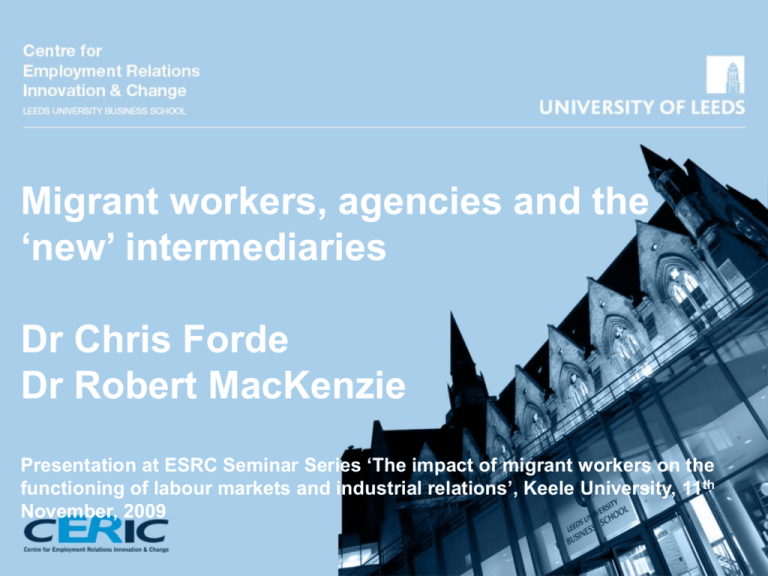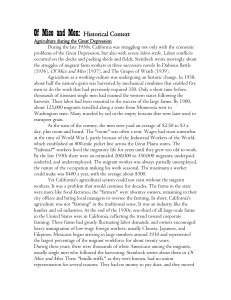Forde and MacKenzie
advertisement

Migrant workers, agencies and the ‘new’ intermediaries Dr Chris Forde Dr Robert MacKenzie Presentation at ESRC Seminar Series ‘The impact of migrant workers on the functioning of labour markets and industrial relations’, Keele University, 11th November, 2009 Context •Recent interest in migration given large increases in flows between countries •Recognition of the long-standing role of employment intermediaries in shaping labour market outcomes for migrants (Piore, 1979; Waldinger, 1986) •‘New’ intermediaries, alongside long-established temporary employment agencies becoming more important in mediating relations between migrants and employers Research questions •Who are the ‘new’ intermediaries and what is their role in mediating the relationship between employers and migrants? •To what extent have established intermediaries adapted their strategies in the light of increased migration? Paper draws on ongoing exploratory research into the experiences of ‘new arrivals’ in the UK and the role of labour market intermediaries (see also MacKenzie and Forde, 2007) http://www.leeds.ac.uk/lubs/CERIC/ceric_report.pdf Background •Recent increases in migration flows worldwide •Current population of A10 nationals in UK is 0.7 million, up from 0.6m in 2004 (Pollard et al, 2008) •Flow of over 1m new arrivals from A10 countries since 2004, but 0.5m have returned to country of origin •Recent inflows need to be placed in the context of longer term migration flows to and from the UK The employment experiences of migrant workers •Migrant workers concentrated in low skilled occupations •Hours of work, on average are higher than UK workers (Pollard et al, 2008) and often in excess of 48-hour maximum prescribed by WTD (MacKenzie and Forde, 2009, forthcoming) •Migrant workers concentrated in low paid jobs (Datta et al, 2007; Holgate 2005) •Outcomes for migrants typically explained with reference to labour market demand •Need for recognition of the role of labour market actors in shaping outcomes Employment intermediaries and migration •Historically close connections between employment intermediaries and migrant workers •Piore (1979) noted the important role of intermediaries (often in countries of origin) in shaping opportunities for migrants, and their contribution to segmentation processes •Waldinger (1986) highlighted how formal and informal intermediaries mediated relations between migrants and small employers in the textile sector •Moore’s (1965) seminal analysis of the temporary help industry in the US revealed how agencies located in areas with large migrant populations •But there remain important gaps in understanding about the relationship between employment intermediaries and migration: reflects broader neglect of the ‘agency of agencies’ in research in this field (see Coe et al, 2009; also Forde, 2008). Employment intermediaries and migration in the UK •Forde and MacKenzie (2007): private employment agencies used by 40% of migrant workers to find work •Second most important method of finding work, behind friends and family • Use of agencies by migrants in country of origin and in the UK •‘Good’ and ‘bad’ agencies identified and reputations spread through informal networks •Resonates with findings from other recent studies in the UK (McDowell et al, 2008; Fitzgerald, 2007; Anderson et al; 2007) The strategies of employment agencies towards migrants •Low barriers to entry in industry: small-independent agencies have ‘led race to the bottom’ (Ward, 2004) competing on the basis of minimum labour costs •Use of migrants may facilitate the large-scale supply by agencies of lowcost ‘warm bodies’ (Parker, 1994) •‘Mass production’ approach to service (see Peck et al, 2005; Hoque et al, 2008) The strategies of employment agencies towards migrants •But use of migrant labour also central to ‘higher value added’ managed relationships between agencies and employers •Success of ‘preferred supplier’ arrangements often dependent upon extensive use of migrants (Zaronite and Terzite, 2007) •‘Master vendor’ relations also heavily dependent upon use of migrant labour (Reed Health, 2008) The project •Research builds on project examining experiences of new arrivals in Barnsley •Current research involves qualitative study of the connections between migration and intermediaries •Aim is to map intermediaries in the UK and explore their strategies towards migrants •Ongoing exploratory case studies: 4 cases presented here Mapping the new intermediaries •Private employment agencies -Permanent placement v temporary help -Multinational v small local -Agencies from country of origin •Labour suppliers in sectors regulated by Gangmasters’ Licensing Authority •Social enterprise agencies •‘Agents’ •The firm as intermediary Case 1: The large multinational agency •KeyStaff is one of the 10 largest global temporary help agencies employment agencies •Competitive strategy based around development of high value added managed contracts •Migrants concentrated in production/operative jobs in food processing and manufacturing industries (typically 30% of managed contract headcount are migrants) •Key positions in agencies staffed by recruitment consultants with Polish language skills •Recruitment strategy changed since 2004 to target Polish job boards and newspapers Keystaff (2) •Rises in number of migrants driven by client… “they keep asking for more Polish workers. They were reliable and hard working and their English language skills meant they were able to deal with the health and safety training” •….but also by the agency “we know the Polish workers will turn up…absence levels for the XXX contract have fallen, they’re reliable and they’ve tended to stay with the contract” •Use of migrants as a means of maintaining margins on contracts in the face of competition from ‘small local’ agencies “we lost a contract to a smaller agency who cut their mark-up to 50p per temp (per hour)….we still emphasise added value, but with migrants we can do this with a lower wage bill” •Informal networks used to fill positions at short notice, to meet client demands for flexibility Case 2: Association of Labour Providers • Association for Labour Providers (ALP) is the trade association for organisations providing temporary labour in the food and agriculture industry • 200 members, supplying 40000 workers daily • Aims to represent interests of labour providers and promote compliance with the GLA • Key lobbying role (over minimum wage, agency working directive, GLA regulations) • Association’s key message emphasises the valuable contribution of migrants to UK economy • 90% of workers supplied by ALP members are migrants, mostly from Eastern Europe Case 2: Association of Labour Providers Development of ‘infrastructure’ to assist with compliance with GLA regulations and to facilitate use of temporary (migrant) labour - Compliance Audit tool: used by clients and agencies – 300 questions focused on compliance with GLA and minimum wage regulations, e.g.: what are wage rates have deductions from wages reduced pay to below NMW? Accommodation offsets etc - The FirstThere Workforce Payment Solution card initially established to provide alternative to wage payment via bank account - payment of wages via prepaid Mastercard -marketed as providing ‘help in solving the dilemmas of transport to work deductions breaching the NMW’ - The ‘national worker transportation scheme’ (in partnership with Stagecoach) “reliable on time worker delivery to shift…and compliance with NMW” Case 3: The social enterprise agency • Social Personnel set up in 2006 with the aim of better serving the needs of migrant workers “it is all about exploitative agencies…but people stick to that because it is all they know” • Began with permanent placement and temporary help, but has diversified into training • partnerships with unions and local FE college • involvement in TUC Vulnerable Work project to establish advice centres for migrants • Key aim of placement activities is to move migrants into higher-skilled jobs • Longer-term perspective focused on developing careers of migrants “there are lots of people involved in recruitment agencies, generally its about placing people and moving…if they have people who are not readily placeable they will not spend time with that person” Case 4: The employer as agency • Glassfix provides a labour intensive quality control and repackaging service to the glass industry in Yorkshire • 90% of 250 strong workforce are migrant workers, mostly from EU A10 countries • Competitive strategy based on minimising labour costs, relying on successive rounds of migration for labour supply Glassfix as intermediary • Shift from patron to supplier of migrants • Based on perceived HRM attributes of migrant workers (strong work ethic, compliance….) • Provided outsourced workers to work in assembly lines of other companies…. Glassfix (2) “It’s almost like an agency, but we’re more expensive, because of the training [we give our people]. Plus they turn up and work a full shift. Agency turn up and they don’t want to do the job… Our people are experienced and understand the production process. 10 of ours would do what 20 agency workers could. They are more expensive, but the costs of ownership are better”. (Glassfix Manager). • Membership of the ALP has formalised company’s status as a labour provider Conclusions • Wide range of intermediaries involved in supply of migrant labour: some new, many long established • Competitive strategies which focus on supply of migrant workers should be seen in the longer-term context of the activities of intermediaries over the twentieth century • Temporary help agencies have always competed through targeting marginalised groups the labour market (Forde, 2008; Gonos, 2008) • Agencies competing on the basis of ‘mass production’ of temps (Peck et al 2005) emphasise stereotypical characteristics of migrant worker groups (work ethic, reliability etc), in line with ‘resource based view’ of firm Conclusions (2) • These characteristics also emphasised by agencies pursuing ‘higher value added’ contracts • But in these higher value added contracts, use of migrants has also allowed agencies to maintain high margins in the face of competition through reduction of labour costs • Development of ‘infrastructure’ to facilitate employers’ use of temporary (migrant) labour is in keeping with longer-term competitive strategies adopted by intermediaries throughout the twentieth century: to expand reach and scope of agencies in labour supply • Some new intermediaries (e.g. social enterprise) emerging, in part, because of employer and employee dissatisfaction with traditional agencies







